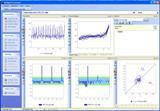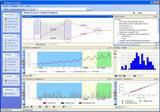|
Tutorial
held at the 2009 International Joint Conference on
Neural Networks (IJCNN'09), Atlanta, USA
"Time Series prediction with
artificial Neural Networks: applications, tricks of
the trade and empirical evidence"
Workshop
held on Sunday, June 14, 4:00PM-6:00PM,
Peachtree Ballroom E
Official webpage:
http://cnd.memphis.edu/ijcnn2009/tutorial-schedule.html
 |
Download the
IJCNN'09 Workshop Presentation
(click on
button)
(if you forgot the workshop password please
contact
s.crone@bis-lab.com) |
|
|
Artificial neural
networks (NN) have revolutionized the way
researchers and practitioners solve complex,
real-world problems in business, finance, economics,
and engineering. Today, NNs are being routinely used
by specialists in a wide range of predictive tasks
such as forecasting electrical load, financial data,
consumer packaged goods in retail and supply chain
management, call volumes in call centres etc.
However, their modelling and specification requires
expert knowledge often not available in companies.
We are pleased to announce short, 2 hour
tutorial on time series prediction and forecasting
to be held at the 2009 International Joint
Conference on Neural Networks (IJCNN'09) organised
by the IEEE Computational Intelligence Society, in
Atlanta, USA.
Course design:
The course will be 2 hours of maths-lite lectures
and hands-on demos using a free NN software
simulator, which we will make available to you after
the course. We will pay particular attention
Target audience:
Whether you are an engineer,
financial analyst, researcher, or student, the
course is designed to provide you with an
introduction to basic and advance issues in
modelling neural networks for time series
prediction, and help you acquire the
knowledge, the skills and the competence you need to
utilize this cutting-edge technology for solving
predictive problems. You will be exposed to the
theoretical concepts and hands-on applications of NN. The hands-on format will
allow you to follow the course even without a sound
mathematical or statistical background. Even if you
are already familiar with ANN, you will learn
tricks-of-the-trade from the trainer's experience
and past forecasting competitions.
Course Coverage:
History of neural networks in forecasting,
specifying neural network architectures (number of
layers, number of nodes, feedback etc.) for
forecasting, Applications of neural networks in
function approximation, linear and nonlinear time
series prediction, hands-on examples in time series
and causal modelling, Fundamentals of time series
forecasting, Modelling neural networks for smoothing
and regression, Evaluating Neural Network
forecasting accuracy, Out-of-Sample Empirical Design
of Neural Network Experiments
Software to be
used:
 Intelligent
Forecaster offers
the first industry-grade software (made in Germany) developed
exclusively and specifically for time series forecasting with
the most up-to-date and advanced methods from Intelligent
Forecaster offers
the first industry-grade software (made in Germany) developed
exclusively and specifically for time series forecasting with
the most up-to-date and advanced methods from
 Artificial Intelligence: Support
Vector Regression (SVR) and artificial Neural Networks (NN).
These allow unprecedented accuracy from nonlinear, data-driven and
non-parametric prediction. The software
provides various expert features (i.e. input-variable
& lag-identification, data-preprocessing,
ensembles) for
multiple forecasting horizons across fixed
forecasting horizon,
rolling origin evaluation across a set of multiple error
measures). [Read
more ...] Artificial Intelligence: Support
Vector Regression (SVR) and artificial Neural Networks (NN).
These allow unprecedented accuracy from nonlinear, data-driven and
non-parametric prediction. The software
provides various expert features (i.e. input-variable
& lag-identification, data-preprocessing,
ensembles) for
multiple forecasting horizons across fixed
forecasting horizon,
rolling origin evaluation across a set of multiple error
measures). [Read
more ...]
|